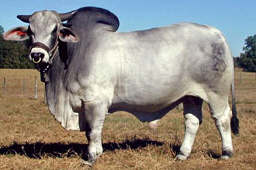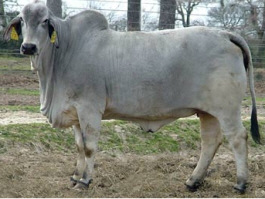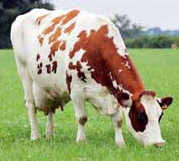



Brahman
History
The Brahman breed (also known as Brahma) originated from Bos indicus cattle from India, the "sacred cattle of India". Through centuries of exposure to inadequate food supplies, insect pests, parasites, diseases and the weather extremes of tropical India, the native cattle developed some remarkable adaptations for survival which cattle producers in the USA found useful and advantageous. Photo courtesy of Tuscany Farms, www.tuscanybrahmans.com |
It is said that during the period from 1910 to 1920, many cattle in the south-western part of Texas and the coastal country along the Gulf of Mexico showed considerable evidence of Bos indicus breeding. Naturally, many of the bulls that were used were the result of crosses with other breeds. Some breeders attempted to keep the stock pure, but they were in the minority.
Since there are records of less than 300 imported Brahmans (most of which were bulls), it must be assumed that other breeds supplied the foundation animals for the breed.
The bulls were used on cows of the European breeds and on the descendants of these crosses. By the fifth generation (31/32) the offspring carried not only a preponderance of Bos indicus breeding but selection pressure had permitted the development of an animal generally regarded as superior to the original imports for beef production.
Today, its use in crossbreeding has become a great tool for the production of steers for various purposes. Its meat is highly appreciated in the five continents.
The Brahman has become so essential in the tropics that many British and Continental breeds have been "adapted" to such zones by incorporating a relevant percentage of Brahman blood. Synthetic breeds have resulted from such crossings: Brangus - Braford - SimBrah - ChaBray - BeefMaster. These are just a few examples of Brahman popularity.
Characteristics
All Bos indicus cattle including the Brahman are characterised by a large hump over the top of the shoulder and neck.Brahmans vary in colour from very light grey or red to almost black. A majority of the breed are light to medium grey. Mature bulls are normally darker than cows and usually have dark areas on the neck, shoulders and lower thighs.
They have short, thick, glossy hair which reflects much of the suns rays and black pigmented skin, making it able to graze in the midday sun without suffering. Their horns curve upwards and sometimes tilt to the rear plus they have pendulous ears.
Brahman have an abundance of loose skin which is thought to contribute to its ability to withstand warm weather by increasing the body surface area exposed to cooling.
Another feature of this breed is the increased number of sweat glands and the ability to sweat freely, Bos indicus cattle also produce an oily secretion from the sebaceous glands which has a distinctive odour and is reported to assist in repelling insects.
Brahmans are intermediate in size among beef breeds. Bulls will generally weigh from 1600 to 2200 pounds and cows from 1000 to 1400 pounds in average condition. The calves are small at birth, weighing 60 to 65 pounds, but grow very rapidly and wean at weights comparable to other breeds.
Brahmans are intelligent, inquisitive and shy. They are unusually thrifty, hardy and adaptable to a wide range of feed and climate. However, these characteristics also suggest careful, kind handling methods. Brahmans like affection and can become very docile. They quickly respond to handling they receive, good or bad. Well bred, wisely selected and properly treated Brahmans are as easily handled as other breeds.
They are also good mothers and produce a very satisfactory milk flow under conditions that are adverse for best performance of the European breeds.
Cancer eye is almost unknown in the breed. They have established a considerable reputation for a high dressing percentage,
 Photo courtesy of Tuscany Farms, www.tuscanybrahmans.com |
Statistics
Comparative
Studies at the University of Missouri found that Brahman and European cattle thrive equally well at temperatures down to 8° F. They found that European cattle begin to suffer adversely as the air temperature goes above 70° F, showing an increase in body temperature and a decline in appetite and milk production as 75° F, is passed. Brahmans, on the other hand, show little effect from temperatures up to and beyond 105° F. Although heat tolerance is only one factor in environmental adaptation of cattle, it is considered the most important.Another factor contributing to the great heat tolerance of Brahmans, discovered in the Missouri studies, is that they produce less internal body heat in warm weather than do cattle of European breeds. Waste heat is produced from feed at the expense of growth and milk production.
www.brahman.org
Distribution
The Brahman is very popular and has been exported from the USA to many beef cattle producing countries including Argentina, Paraguay, Mexico, Brazil, South Africa and Australia.References (the above information was cited from the following sites)
www.brahman.org
www.viarural.com.ar/brahman
www.tuscanybrahmans.com


